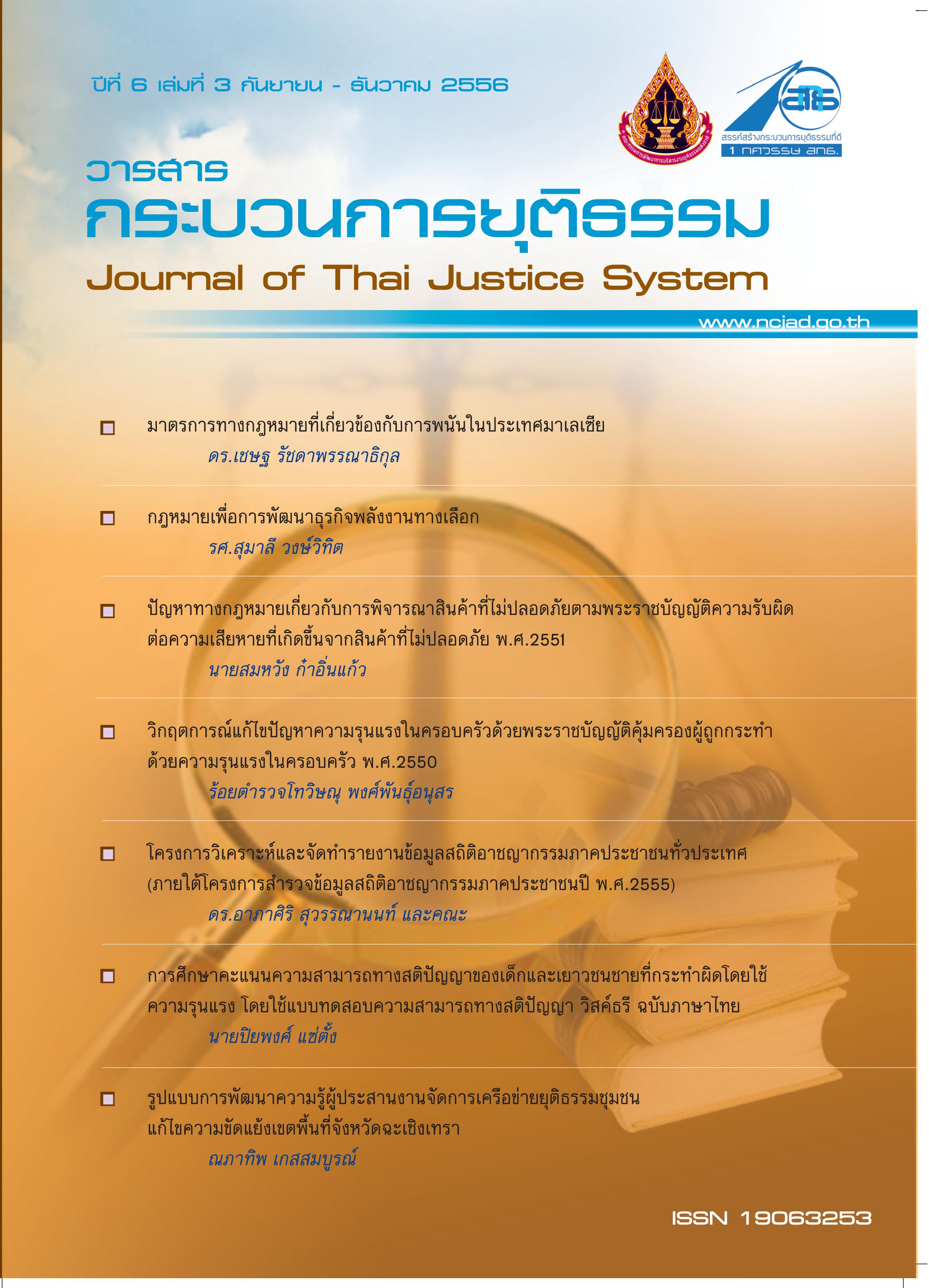การศึกษาคะแนนความสามารถทางสติปัญญาของเด็กและเยาวชนชายที่กระทำผิดโดยใช้ความรุนแรงโดยใช้แบบทดสอบความสามารถทางสติปัญญาวิสค์ธรี ฉบับภาษาไทย
Main Article Content
บทคัดย่อ
การวิจัยครั้งนี้เป็นการวิจัยเชิงพรรณาเพื่อศึกษาคะแนนความสามารทางสติปัญญาในเด้กและเยาวชนชายที่กระทำผิดโดยใช้ความรุนแรงโดยใช้แบบทดสอบความสามารถทางสติปัญญาวิสค์ธรี ฉบับภาษาไทย ศึกษากลุ่มตัวอย่างเป็นเด็กและเยาวชนชายที่กระทำผิดโดยใช้ความรุนแรงที่อยู่ในความดูแลของสถานพินิจและคุ้มครองเด็กและเยาวชนกรุงเทพมหานคร จำนวน 36 คน ใช้วิธีการคัดเลือกกลุ่มตัวอย่างแบบเฉพาะเจาะจง ระหว่างเดือนมกราคม - ธันวาคม 2554 ทั้งนี้เครื่องมือที่ใช้ในการวิจัยประกอบด้วยแบบสอบถามเพื่อเก็บข้อมูลทางประชากรศาสตร์และแบบทดสอบควาสามารถทางสติปัญญาวิสค์ธรีฉบับภาษาไทย (WISC-III: Thai version) ผู้วิจัยวิเคราะห์ข้อมูลโดยสถิติเชิงพรรณนา ได้แก่ แจกแจงความถี่ ร้อยละ ค่าเฉลี่ย ส่วนเบี่ยงเบนมาตรฐาน และ เปรียบเทียบความแตกต่างระหว่างคะแนนความสามารถทางสติปัญญาภาคภาษาและการกระทำโดยใช้ paired sample t-test ผลการศึกษาพบว่าเด็กและเยาวชนชายที่กระทำผิดโดยใช้ความรุนแรงส่วนใหญ่มีระดับสติปัญญาทึบมาก(ร้อยละ 42, M = 80.19, S.D. = 9.48) เช่นเดียวกับคะแนนความสามารถทางสติปัญญาภาคภาษา (Verbal IQ) ส่วนใหญ่อยู่ในระดับทึบมาก (ร้อยละ 44, M = 79.58, S.D. = 8.17) ในขณะที่คะแนนความสามารทางสติปัญญาภาคการกระทำ (Performance IQ) ส่วนใหญ่อยู่ในระดับปานกลาง (ร้อยละ 36, M = 84.47, S.D. = 12.53) และผลการศึกษาเปรียบเทียบพบว่าเด็กและเยาวชนชายที่กระทำผิดโดยใช้ความรุนแรงมีคะแนนความสามารถทางสติปัญญาภาคภาษาน้อยกว่าคะแนนความสามารถทางสติปัญญาภาคกระทำอย่างมีนัยสำคัญทางสถิติที่ระดับ .05 จากการวิจัยในครั้งนี้พบว่าการได้คะแนนความสามารถทางสติปัญญาภาคภาษาต่ำนั้นเป็นตัวชี้วัดสำคัญที่บ่งชี้ความบกพร่องทางสติปัญญาในหมู่เด็กและเยาวชนชายที่กระทำผิดโดยใช้ความรุนแรง
Article Details
ต้นฉบับที่ได้รับการตีพิมพ์ในวารสาร เป็นลิขสิทธิ์ของวารสารกระบวนการยุติธรรม แต่ความคิดเห็นที่ปรากฏในเนื้อหาของบทความในวารสารกระบวนการยุติธรรม ถือเป็นความรับผิดชอบของผู้เขียนแต่เพียงผู้เดียว
References
กนกพร บุปผาชาติ. (2539). ความหวาดกลัวอาชญากรรมของผู้หญิง. วิทยานิพนธ์สังคมวิทยาและมานุษยวิทยามหาบัณฑิต, มหาวิทยาลัยธรรมศาสตร์.
กอบโชค จูวงษ์. (2541). การทำร้ายผู้อื่นของวัยรุ่นในภาคใต้. ค้นเมื่อ 21 ตุลาคม 2552, จาก http://mhtech.dmh.moph.go.th/lib/search/body.php?lib_id=102.
นัทธี จิตสว่าง. (2547). โปรแกรมแก้ไขฟื้นฟูผู้กระทำผิด. กรุงเทพฯ: โรงพิมพ์วัฒนาพงษ์การพิมพ์.
ปราณี ชาญณรงค์, ชนิสา เวชวิรุฬห์ และ กาญจนา วณิชรมณีย์. (2547). คู่มือการใช้แบบทดสอบวัดความสามารถทางสติปัญญา WISC-III ฉบับภาษาไทย. นนทบุรี: กรมสุขภาพจิต.
วิมลวรรณ ปัญญาว่อง. (2550). ปัจจัยที่มีอิทธิพลต่อการกระทำผิดซ้ำของเยาวชนผู้กระทำผิด. วิทยานิพนธ์ ปริญญาวิทยาศาสตร์มหาบัณฑิต, สาขาจิตวิทยาคลินิก บัณฑิตวิทยาลัย มหาวิทยาลัยมหิดล.
สุชีรา ภัทรายุตรววรตน์, กนกรัตน์ สุขะตุงคะ, จริยา จันตระ, วิลาสินี ชัยสิทธิ์, กีรติ บรรณกุลโรจน์ และสร้อยสุดา อิ่มอรุณรักษ์. (2543). การสร้างเกณฑ์ปกติของแบบทดสอบ Standard Progressive Matrices ในกลุ่มประชากรไทย. วารสารสมาคมจิตแพทย์แห่งประเทศไทย, 45(1), 45-57.
อัณณพ ชูบำรุง และศรีสมบัติ โชคประจักษ์ชัด. (2538). ว่าด้วยเหยื่ออาชญากรรม. นครปฐม: โรงพิมพ์สถาบันพัฒนาสาธารณสุขอาเซียน.
อุมาพร ตรังคสมบัติ. (2549). ความรุนแรงในวัยรุ่นไทย : รายงานการทบทวนองค์ความและข้อเสนอแนะเชิงนโยบาย. กรุงเทพฯ: โรงพิมพ์องค์การสงเคราะห์ทหารผ่านศึก.
Barlow, D.H. (1996). Introduction to criminology (7th ed.). New York:HarperCollins.
Cornell, D. G., Wilson, L.A. (1992). The PIQ > VIQ discrepancy in violent and nonviolent delinquents. Journal of Clinical Psychology, 48(2), 256-257.
Dewolfe, A. S. and Ryan, J. J. (1984). Wechsler performance IQ > verbal IQ index in a forensic sample:: A Reconsideration. Journal of Clinical Psychology, 40(1). 291-294.
Farrington, D.P. (2005). Childhood Origins of Antisocial Behavior. Clinical Psychology and Psychotherapy. 12, 177-190.
Farrington, D.P. & Loeber, R. (2000). Epidemiology of juvenile violence. Child and Adolescent Psychiatric Clinics of north America, 9(4), 733-748.
Harada, Y., Satoh, Y., Sakuma, A., Imai, A., Tamaru, T., Takahashi, T. and Amano, N. (2002). Behavioral and developmental disorders among conduct disorder. Psychiatry and Clinical Neurosciences, 56:621-625
Isen, J. (2010). A meta-analytic assessment of Wechsler's P>V sign in antisocial populations. Clinical Psychology Review, 30:423-435
Kamphaus, R.W. (1993). Clinical assessment of children's intelligence. MA:Allyn and Bacon.
Koolhof, R., Loeber, R., Wei, E. H., Pardini, D. and D'Escury, A. C. (2007). Inhibition deficits of serious delinquent boys of low intelligence. Criminal Behavior and Mental Health, 17:274-292.
Krol, N., Morton, J., and De Bruyn, E. (2004). Theories o conduct dieorder: a causal modeling analysis. Journal of Child Psychology and Psychiatry, 45(4), 727-742.
Pimpan Sipasuwan, Supaporn Upalabat, Chukiat Viwatwongkasem, Pitakpol Boonyamalik and Dusit Sujirarat. (2011). Violence Recidivism among Thai Juvenile Delinquents. Asia Journal of Public Health, 2(1):13-19.
Shader, M. (n.d.). Risk factors for delinquency: an overview. Retrieved January 15, 2011, from http://ww.ncjrs.gov/pdffiles1/ojjdp/frd030127.pdf
Wong, W.and Cornell, D.G. (1999). PIQ > VIQ Discrepancy as a Correlate of Social Problem Solving and Aggression in Delinquent Adolescent Males. Journal of Psychoeducational Assessment, 17:104-112

